Cardo Scala Rider Q1 TeamSet and Q3 MultiSet Intercoms
The Cardo Scala Rider Q1 TeamSet and Q3 MultiSet are new, small form factor Bluetooth motorcycle intercoms.
The Q1 was primarily designed to be a simple, easy-to-use, short range, full-duplex intercom for a rider and passenger on one bike.
The Cardo Scala Rider Q3 uses the same form factor as the Q1 but it has more advanced features, including the ability to pair with up to four other Q3 intercoms.
Both the Q1 and Q3 have the new Cardo “Music Sharing” function which means that both users can listen to the same connected media player simultaneously.
The Cardo Scala Rider Q1 TeamSet and Scala Rider Q3 MultiSet are small, easy-to-use intercoms with that distinctive Cardo shape and down-sized mounting components.
With the size and bulk trimmed, a tight profile and minimal footprint, the Q1 and Q3 look good and fit any helmet.
Despite giving up one or two features found in the technology-packed Cardo Scala Rider G9 (review), the Q1 and Q3 can go module-to-module and feature-to-feature with almost anything else on the market and either win or come out very near the top.
Other than intercom range and some pairing differences, the Q1 TeamSet and Q3 MultiSet have an identical look, feel and functionality.
Motorcyclists who desire a dedicated rider-with-passenger capability will find the shorter-range Q1 TeamSet just about perfect and the Q3 MultiSet, with its 1 kilometer range, may be a near-perfect solution for groups of up to 4 riders.
Also, both the Q1 and Q3 intercoms include the new Cardo “Music Sharing” feature, which is easily activated by the sending unit, resulting in high-quality stereo audio wirelessly streamed to the receiving unit so that both parties can enjoy the same music.
This feature isn’t as fully integrated as other audio services, but it works extremely well and it can eliminate the need for a shared wired connection or third-party music streaming solution like the Sena SM10 Stereo Bluetooth Transmitter (review).
The Scala Rider Q1 and Q3 intercoms are priced aggressively and they are also compatible with the Cardo Scala Rider G9, G4, Q1, Q2 Pro and SCHUBERTH SRC intercom systems.
Bottom line: based on price, design, features and performance, the Cardo Scala Rider Q1 TeamSet and Scala Rider Q3 MultiSet are the hot picks for the Summer of 2013.
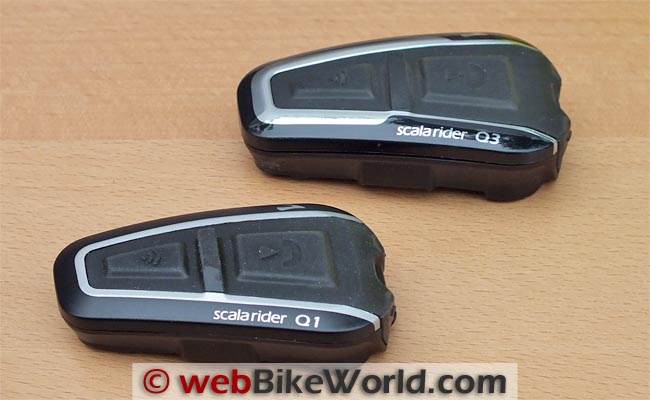
Cardo Scala Rider Q1 TeamSet and Q3 MultiSet: Common Features
In case you are wondering, yes, the new Cardo Scala Rider Q1 TeamSet is nearly identical to the Q3 MultiSet, other than cosmetics on the intercom modules and a few model-specific features.
The boxes are differentiated only by the sleeve labels and the intercom modules by a brushed finish on the Q1 versus a gloss finish on the Q3. Open the box and the kits are nicely packed, physically and literally.
There are a lot of goodies provided with each, starting with, of course, the two pre-paired intercoms in each set.
The face of both the Q1 and Q3 intercom module features two large shaped controls.
The control towards the front is the intercom or “IC” button and towards the rear of the raised molding that houses the LEDs is the larger “Music/Mobile” or “MM” button. Remember those acronyms because we’ll be using them as we get deeper into this review!
The back edge of each intercom module features two long narrow buttons: Volume Up (Vol+) and Volume Down (Vol-) separated by a micro-USB port that is the interface for charging, firmware updates and auxiliary audio input.
When not in use, this port is secured with a soft tethered push-plug.
More modular than the Scala Rider G9, the Q1 and Q3 intercom systems feature replaceable stereo speakers connected via a 3.5 mm port on the back of the base unit, with the interchangeable and replaceable hybrid (boom) or corded microphones connected using a 2.5 mm connector.
Comparing features, the Q1 TeamSet and Q3 MultiSet intercoms have logically and wisely inherited a big slice of the G9 firmware, less the “Eight+1” connectivity and voice command capabilities and other features.
Cardo provides a good informative online comparison table of the Q1 TeamSet and Q3 MultiSet intercoms with more detailed information.
Both the Q1 and Q3 feature full duplex communications, with the Q1 TeamSet intercom having limited range.
That’s because the pair is designed to be used as a rider and passenger system for one motorcycle, whilst the Q3 MultiSet has more reach, stated as up to 1 kilometer under normal conditions and can be paired with up to 4 other Q3 systems.
Click-to-Link
The exclusive Cardo “Click-to-Link” feature, first introduced in the G9, allows riders or passengers to create a spontaneous pairing between compatible Cardo Scala Rider devices owned by any one of the thousands of Scala Rider users who are potential contacts.
This feature, if enabled (using the Voice Menu setup or via the Cardo Community interface), is activated by pressing “MM” for two seconds.
And while this handy feature is found on the Q1/Q3 systems, a companion capability “Flash Pairing”, introduced on the Cardo Scala Rider G9, which allows instant pairing by tapping the intercom modules together, is not present on the Q1/Q3 intercom systems.
Multi-Device Connectivity
The Cardo “Multi Device Connectivity” or MDC is found on both the Q1 TeamSet and Q3 MultiSet, providing two Bluetooth channels for parallel connectivity to two mobile phones, a navigation device and/or A2DP-enabled music players.
FM Radio
And let’s not forget the built-in FM radio with RDS, six pre-sets, auto-scan and signal optimization. FM radio is becoming standard for motorcycle intercoms and why not? It’s ideal for local coverage and especially for weather reports when travelling.
For connecting non-Bluetooth devices to the Q1 or Q3, a micro-USB to 3.5 mm stereo cable is provided for auxiliary inputs.
Cardo Music Sharing
And saving what is likely one of the most welcome features for last, the Q1 and Q3 intercoms include the Cardo Music Sharing capability.
Both the Q1 and Q3 systems provide reliable high-quality music sharing between two headsets via A2DP with a range of about 10 meters — and sometimes a bit more under good conditions.
Like other Cardo Scala Rider intercoms, the Q1 and Q3 modules are IP67 (Waterproof and Dustproof) certified.
And also like most other intercoms on the market, both are fully firmware-updatable via the Cardo social network website, described in the original G9 review. The online system is both Windows or Mac compatible.
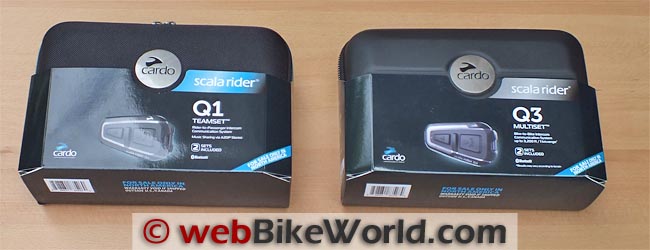
Where to Buy Cardo Scala Rider Q1 TeamSet and Q3 MultiSet Intercom
Check Reviews & Prices on Amazon Check Reviews & Prices On RevZillaSee More: Motorcycle Intercom, Motorcycle Accessories, Motorcycle Helmets
Cardo Scala Rider Q1 and Q3 System Features and Functions
Components
The small and slim Q1 and Q3 units are visually appealing, far more so than the stylized but larger G4 and G9 intercoms. From my perspective, this is what the G9 should have and could have been, although the still-leading-edge G9 has attributes that dictate its size and shape…sort of.
Helmet Mounting
The helmet clamp mount has been downsized for the Q1 and Q3, but its design hasn’t done anything to reduce how far it extends: 2 to 4 cm (~1 to 1.5″) below the bottom of the helmet. There are other solutions; c’mon Cardo!
To their credit, Cardo does provide two different adhesive mounts.
One is a smaller mount in black plastic and similar in shape to other Scala Rider adhesive mounts and a larger version in clear plastic, which is more discreet with adhesive backing only on the top half.
Owners can mount whichever is the best solution for a particular helmet.
I rate the Cardo Scala Rider Q1 and Q3 as above average, however, in this category and despite the bottom overhang issue, the Q1 and Q3 are more modular than the G4 and G9 systems and they have a cleaner look and appear “right-sized” overall.
IP67 Rating and Module Integrity
The small micro-USB port on the inner back of the Q1 and Q3 intercom modules is sealed with a small soft tether plug that is intended to provide a complete seal based on the system’s IP67 rating.
Note that the plug must be carefully and fully inserted into the port to provide the needed protection against the elements.
A couple of trips in heavy rain didn’t result in any moisture damage that I noticed, but I detected some slight seepage when the plug was pulled out.
The position of the USB port on the inner back side of the intercom module helps maintain integrity; it is close to the helmet and somewhat out of the way regarding direct exposure to the elements.
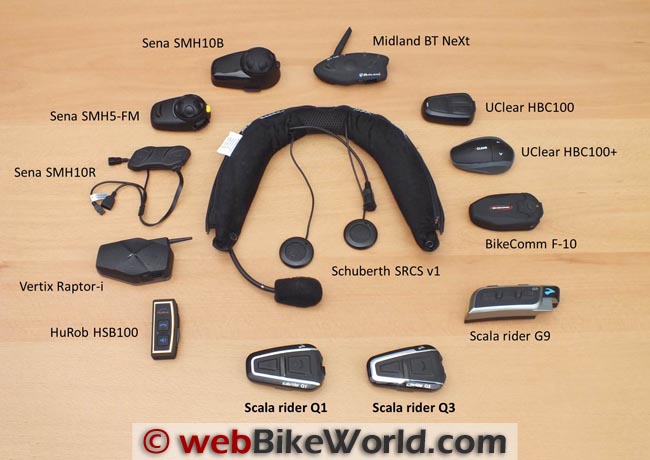
Multi-Device Connectivity (MDC)
Like the Scala Rider G4 and G9 intercoms, the new Q1 and Q3 models have Multi-Device Connectivity (MDC), now further enhanced by dual Bluetooth channels and a “Dual-Handsfree” profile capability.
Management of paired devices or audio channels is based on defined audio priorities (see Audio Priorities below), although the Q1 and Q3 intercoms have some audio priority flexibility.
With dual Bluetooth channels, the intercoms support two similar devices (e.g., two smart phones or a smart phone and multi-function navigation device) at the same time. When services from one device are stopped, the other device can be used.
Bluetooth Pairing and Channel Management
With two discrete Bluetooth channels available, Bluetooth devices are paired to Channel 1 or 2 (the Vol+ and Vol- buttons respectively), similar to the process used with the Midland BT NeXt Bluetooth intercom system (review).
From standby, pressing either Vol+ or Vol- button for five seconds initiates the red/blue LED flashing sequence for the target device to find, negotiate and pair with the Q1 or Q3 headset module.
It is painless and extremely fast; however, the Garmin zumo 660 GPS (review) and Garmin zumo 665 GPS are just plain cranky, as always.
A device on either of the two Bluetooth channels can be set as the default device. When two mobile phones are paired, one must be set as default for outgoing calls.
Setting this priority can be done by pressing “MM” for five seconds (the spoken status announcement “Voice” will let you know which of the two Bluetooth enabled devices is default) or, while on a phone call, press V+ for five seconds to set the active phone as the default device.
Audio Priorities and Switching
As with most motorcycle Bluetooth intercom communications systems on the market today (including the Scala Rider family), the “fixed” audio priorities are:
- Phone or Navigation device;
- Intercom/Click-to-Link;
- A2DP stereo Bluetooth audio;
- FM radio; and
- Auxiliary (wired) connection.
But the Scala Rider Q1 and Q3 intercoms allow a bit of tailoring to the fixed audio priorities to suit user requirements, with the A2DP priority (3rd) being swappable with the Intercom (2nd) audio priority.
This is a simple change to be sure, but appreciated and possibly a sign of what could come. Note that this change can only be done via the online Cardo Community and by signing in as a registered user.
So whether the default audio priorities are kept or the intercom and A2DP inputs swapped around, audio switching and muting between the various sources is 99% accurate and — less the exceptions noted below — very fast, as in 1 to 3 seconds typically.
Example: With FM activated, starting A2DP audio from a connected device brings about streaming immediately (as the higher priority), with a single push on the “IC” button initiating the intercom.
This is identified by the “opening a channel” tonal sequence heard within 1 to 2 seconds, after which the noise free link is open.
The only extended timeouts come when stopping an A2DP stream and waiting for the FM radio to come back; this can take a count of 8 to 10 seconds. Moving between devices paired on “A” (iPhone) and “B” (zumo 665) takes four to five seconds.
Rating: I’ll give the Q1 and Q3 an “Outstanding” in this category.
System glitches and lost connections are almost completely absent, especially with the v1.1 firmware installed and the systems fine-tuned using input settings or the on-line interface.
The timings used above are averaged from a minimum of ten timing samples per device.
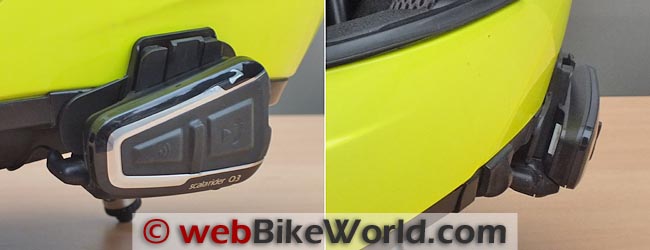
Automatic Gain Control (AGC) and VOX Performance of the Cardo Scala Rider Q1 and Q3
While automatic or audio gain control (AGC) is a de facto standard for Bluetooth motorcycle helmet intercom systems, it seems the VOX feature has been in a decline with many manufacturers, using it for phone-VOX purposes only.
This addresses hands-free concerns and takes advantage of answering features found on most mobile phones.
Cardo has been one of the pioneers regarding AGC and VOX, and while related Cardo Scala Rider G4 (review) performance was somewhat basic, it did provide user configurability.
The Cardo Scala Rider G9 (review) was a new baseline, however, and from my perspective, a whole new ball game regarding AGC and VOX performance…so I really didn’t expect anything less for the new Q1 and Q3 systems.
Automatic Gain Control (AGC)
AGC or “self-adjusting speaker volume” as implemented by Cardo, is the best in the business (period) and the ultra-responsive, ultra-linear AGC is, as far as I know, pretty much an industry exclusive.
Tailorable for specific riding environments, the following sensitivity settings are available: Low = activation at higher speeds; Medium = default setting; and, High = activation at lower speeds.
Voice-Activation (VOX)
The VOX feature can be turned of or on and if activated, set to one of three discrete settings: Low = harder to activate; Medium = default; and High = easier to activate.
Both AGC and VOX settings can be configured via the on-line Cardo Community interface or by manipulating the input buttons on the Q1 or Q3 in the required sequence, all detailed in the manual.
Acknowledging that intercom systems like the Midland BT NeXt, the Cardo Scala Rider G9 and now the Cardo Scala Rider Q1 and Q3 really can and do provide a good VOX capability, I still just turn it off and manually open or close an intercom session.
But in providing “tunable” AGC and VOX features, Cardo addresses some of the biggest and most annoying issues experienced by riders with their Bluetooth intercoms.
And no matter whether cockpit and helmet environments are quiet, noisy or somewhere in between, time spent in tuning the Q1 and Q3 systems pays big dividends in mitigating some or all of the issues.
Despite a rocky start, I got the VOX-activated call answering capability working; after the second or third ring in the headset, a short tone will be heard, after which saying “Hello” (loudly) will answer the incoming call.
Even with two mobile phones paired, the intercom will smoothly hand off the incoming call to the Q1 or Q3 headset, allowing VOX-based call answering.
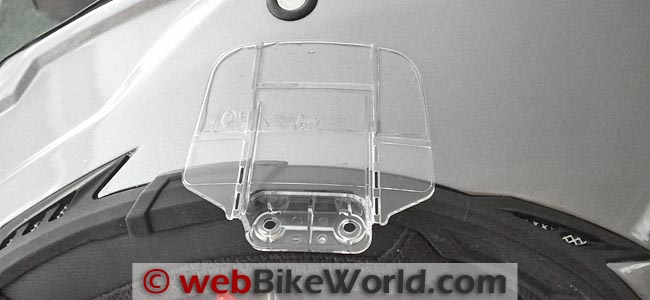
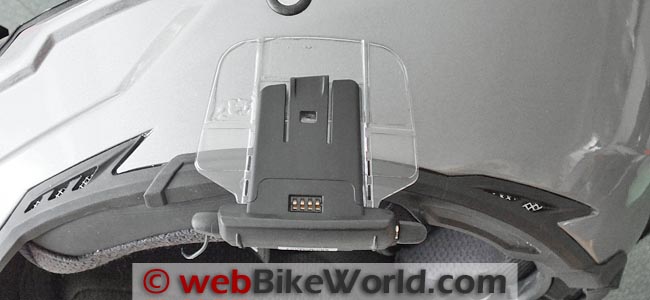
Q1 TeamSet and Q3 MultiSet Audio Performance
Cardo Scala Rider intercom systems usually have good headsets, but they don’t typically fare well against some of the audibly superior helmet system headsets, such as those from UClear and Vertix coming to mind.
But without knowing the technical specifics, the Scala Rider Q1 and Q3 headset performance is much (much) better than what I experienced with the Scala Rider G9, subjectively speaking of course.
The disclaimer here is that every headset functions and sounds different in different helmets, due to helmet shell size, shape, interior fittings, speaker accommodation, etc.
Music Sharing
Between two compatible and paired systems, like the Q1 and Q3 intercoms, music sharing lets the rider and passenger listen to the same Bluetooth stereo (A2DP) music stream being received by the sender’s headset.
During this paired device to headset streaming, the sender initiates music sharing by pushing V+ or V- for two seconds.
After some negotiation between the headsets, a tonal sequence will be heard and the music will be streamed into the receiver’s headset. Either party can stop the sharing, but only the sender can initiate.
Initial tests with the Q1 and Q3 systems weren’t very encouraging, to say the least.
With an active stereo stream from an iPhone going to the headset (sender), pushing V+ or V- for two seconds initiated the music sharing link to the receiver headset, but it stopped just as suddenly and remained intermittent and disruptive.
After providing some feedback to Cardo, an advisory about the availability of the first firmware update was provided and with the Q3 intercoms updated to firmware v1.1, music sharing worked almost flawlessly.
The Q1 intercoms were subsequently updated with the same positive results, and it was now possible to initiate the sharing from either headset.
This feature could still be a work in progress, but so far, so good. It must be manually started and stopped, but regardless, it gives users a built-in rather than a third party solution.
Just remember that phone, GPS and intercom audio will stop a music sharing session and manual initiation will be needed to restart the feature.
FM Radio with RDS
Similar to most of the other motorcycle intercoms that provide an integrated FM radio capability, the FM capability of the Cardo Scala Rider Q1 and Q3 provides stereo with six station presets that can be automatically scanned.
RDS, if activated, provides automatic selection of the strongest signal for that frequency or station.
Wired Connectivity
This is a handy option allowing non-Bluetooth or additional music peripherals to be connected using the supplied micro-USB to 3.5 mm stereo coiled connector cable.
As priority number 5, it sits at the bottom of the audio source list and as such will be interrupted by any of the other audio sources.
The only observations to be made here are that the initial volume setting for this source is basically zero, so some exercising of the V+ button will be needed.
Also, the housing around the 3.5 mm connector on the cable is too large and unless the stereo output port of the peripheral device is flush mounted, the connector probably won’t seat properly; particularly true when the peripheral is housed in a protective case.
Rating: I’ll give the Cardo Scala Rider Q1 and Q3 an “Outstanding” here. System output and speaker performance is (objectively assessed) much improved over other Scala Rider products.
And in three favoured helmets performance from the smallish speakers is on par with UClear, Vertix and Sena Bluetooth intercom headsets.
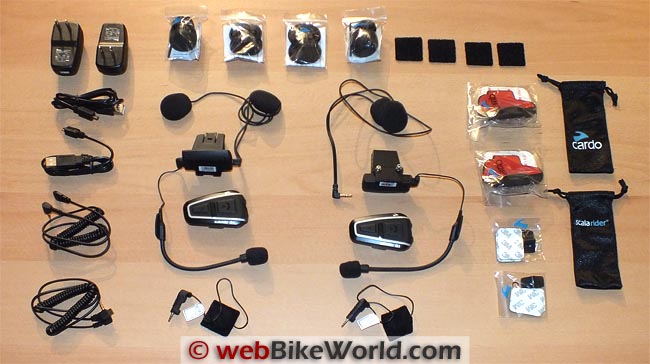
Where to Buy Cardo Scala Rider Q1 TeamSet and Q3 MultiSet Intercom
Check Reviews & Prices on Amazon Check Reviews & Prices On RevZillaSee More: Motorcycle Intercom, Motorcycle Accessories, Motorcycle Helmets
Helmet Installation
As reflected in the Scala Rider Q1 and Q3 Audio Environment Rating table, a number of helmets of different types and size hosted the Q1 and Q3 intercoms for extended periods of time.
Having four almost identical and compatible systems on hand made it much easier to conduct fitment, compatibility and audio assessments concurrently.
With everything supplied in the Q1 and Q3 kits, no issues were encountered in fitting the intercoms to any helmet; even the hybrid microphone with its 18 cm (7″) long boom found a home in all of the modular helmets I tried.
The speakers are small compared to most found on other systems but as such are easy to install even in tight spots and very much adjustable.
The only observation I made is the need to remove a small plate on the back of the base to change the microphone components. This plate locks the larger and somewhat complex-shaped molding surround the 2.5 mm stereo connector on the microphone assemblies.
I understand the strength and durability concerns, especially for the boom, but the connection could be made much simpler.
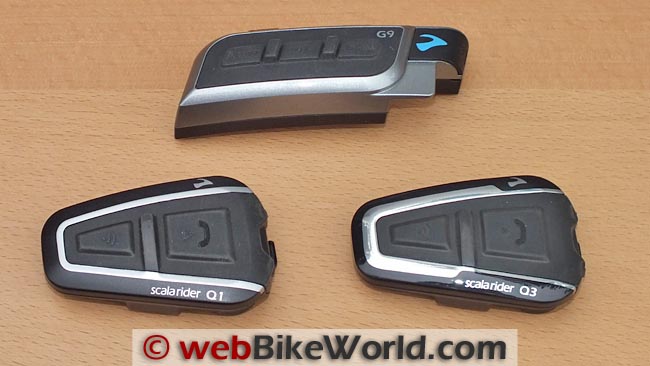
System Management
As our motorcycle Bluetooth intercom systems become more advanced and packed with technology, most have either remained or become even easier to use, while providing reliable performance under even extreme conditions.
The Cardo Scala Rider Q1 and Q3 intercoms are excellent examples of how it should and can be done.
Charging
After one full day of using the Q1 and Q3 intercoms, recharging typically it takes up to two hours using the AC/DC adapter or 4-5 hours via the “trickle-charge” from a powered USB port on a computer.
Battery capacity of the Q1 and Q3 is rated at 400mAh. And no, the systems cannot be charged and used at the same time…downer.
Battery Performance
In spending six to eight hours or more in the saddle on any given day or on successive days and while using the Q1 and Q3 intercoms only as a mobile phone link, the battery went two to three days before showing 50% remaining.
Slightly less life will be seen if the FM radio is on most of the time.
When doing the road trip thing, with the Q1 or Q3 active most of the time (with or without VOX) the intercoms have gone up to two days on a single charge, although again this longevity diminishes if either system sees continued stereo streaming.
Battery status is checked from standby mode by pressing V+ for two seconds to see which condition is indicated on the LED: Blue LED = full charge; Purple LED = half charge; and, Red LED = close to empty.
Reboot/Reset
A quick reset is accomplished simply by turning the module off and then on again (press “IC” for two seconds).
If a full reset is desired or needed (which will delete all currently paired devices), make sure the module is in standby, then press V+ for five seconds until the LED flashes red/blue, now press “MM” for two seconds until the LED flashes purple five times.
Firmware Updates
Firmware version 1.1 was released in June of 2013. For both the Q1 and Q3 intercom systems, version 1.1 provided improved system audio indications and compatibility with some GPS devices (not identified, but the zumo 660 and 665 work better).
It also added muting for the intercom that is receiving the data stream when Music Sharing is activated, along with other unidentified bug fixes and improvements.
Cardo Community
Love it or hate it, registration and use of the online community and device interface page is the only way to update the Scala Rider Q1 and Q3 applications and firmware.
Thankfully, users can still make almost all configuration changes using the Setup menu on the intercoms, less the audio priority swap that can only be done via the on-line configuration menu.
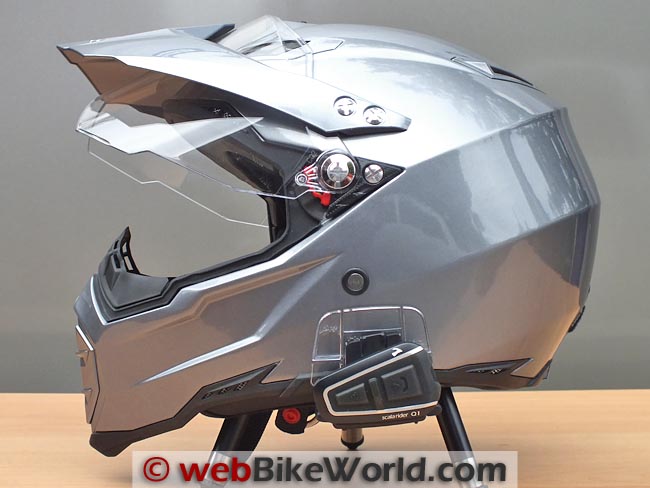
On The Road With the Cardo Scala Rider Q1 and Q3
It takes about 30 seconds or so after turning the Q1 or Q3 intercoms on for the systems to run through their start-up checks.
If a paired intercom is nearby and on, the familiar “Rider-A Connected” will resound loudly in the headset (I wish they would allow volume control of the spoken status announcements).
With a Garmin zumo 665 GPS paired on Channel 2 and an iPhone 4S on Channel 1 or with another mobile phone replacing the Garmin GPS, activating the FM with a double push on the “MM” button produces crystal-clear stereo audio.
And if an A2DP music player (MP3, etc.) is activated for music streaming, its audio replaces the FM stream almost instantly.
If two cell phones are connected and a call comes in on either phone, it is passed to the intercom headset typically on the first ring.
If it’s enabled, VOX will be active after the second or third ring; saying “Hello” will answer the call, as will a tap on the MM button; tapping both MM and IC simultaneously will activate voice dialing, if supported by the paired device/devices.
Calls made to my home phone number and recorded on voice mail were clear, but somewhat weak and scratchy; people on the other end were prone to notice some noise and signal degradation, issues not observed with the UClear HBC200 (review) or Vertix Raptor-i (review)intercoms we have reviewed.
Audio Streaming Reconnection
Once a phone call is completed (or not answered), the audio stream that was previously connected to the Q1 or Q3 intercom will resume in about 4-5 seconds or less, without any intervention required.
One exception was the legacy work phone (two years old) that typically needed to have its music player manually restarted after a phone call, although this issue didn’t arise when using the intercom or any of the other audio sources.
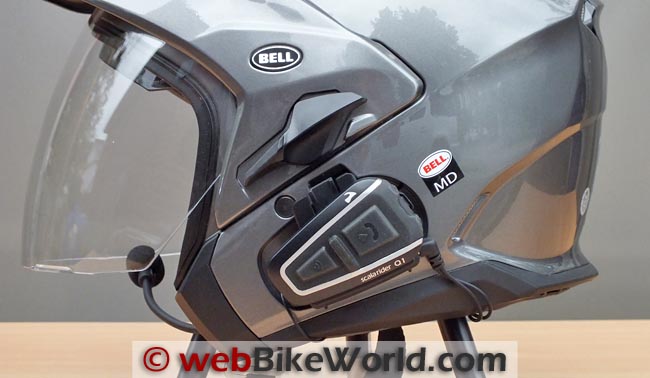
Intercom Audio Quality and Range
If it weren’t for the link tone, which isn’t always audible, it is very difficult to tell when an active device is connected to a Q1 or Q3 intercom, other than hearing the other party breathing.
Between the virtually noise-free Q1 or Q3 intercom, with its super-responsive AGC and tunable VOX (if enabled) and excellent range from both devices, overall intercom performance of the Scala Rider Q1 and Q3 intercoms is far better than the performance of the Scala Rider G9 intercoms we reviewed.
Somewhat surprisingly, the functional range of the Scala Rider Q1, which is actually designed to be a short-range, rider-and-passenger intercom, was around 90 to 150 metres (300 to 500 feet). So as noted, for around town, the Q1 seems viable for rider-to-rider use as well.
The Scala Rider Q3, as expected, was able to maintain communications out to 1000 metres and beyond without much issue.
Although its intercom seems relatively more prone to noise and fading when the terrain changes than other motorcycle Bluetooth intercom systems we have reviewed, such as the Midland BT NeXt (review).
Both Scala Rider Q1 and Q3 intercoms, like other top-performers, maintain clear audio right out to their maximum range, after which the link drops but is automatically restored once the parties are in range again.
In the right helmet and riding a motorcycle with a fairing and/or a good windscreen, audio performance from the Q1 and Q3 is outstanding; not quite on par with the UClear or Vertix Raptor-i intercoms, but close.
On un-faired motorcycles where noise is always a constant, helmet audio with the Q1 and Q3 typically remains good, although system volume may need to be bumped up one or two notches.
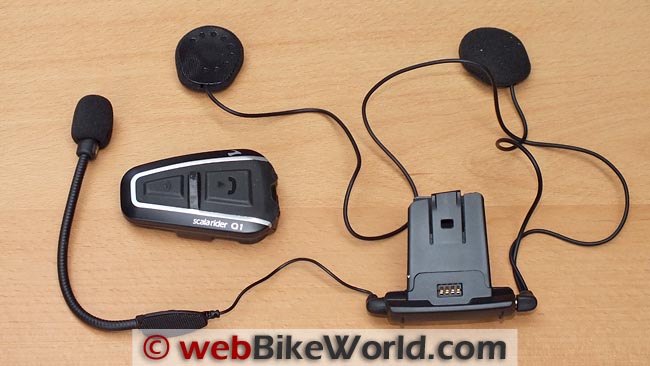
Where to Buy Cardo Scala Rider Q1 TeamSet and Q3 MultiSet Intercom
Check Reviews & Prices on Amazon Check Reviews & Prices On RevZillaSee More: Motorcycle Intercom, Motorcycle Accessories, Motorcycle Helmets
Cardo Scala Rider Q1 and Q3 Intercom Observations
In undertaking some extra Bluetooth discovery activities and in general just playing with the Q1 and Q3 intercoms, some interesting observations were made, presented here for more information.
Bluetooth Related
Both the Gen 3 iPod and iPhone 4S would allow two simultaneous connections by the Q1 and Q3 intercoms as reflected in the screens of the devices.
And when two of the Q1 or Q3 intercoms were connected in this manner, the “Last-In, First Out” or LIFO principle could be applied, allowing either intercom to stop and then start (via AVRCP) the A2DP stream of a Bluetooth peripheral paired to one of the systems.
Audio Related
Activating the FM radio and Auxiliary audio on the Q1 or Q3 causes the volume to go to previously set levels, then it increases for a second or two as if noise level sampling is ongoing, then it settles back to the set volume level.
On occasion, when the FM radio is activated, the volume increases dramatically and does not go down automatically, necessitating some hasty “V-” (Volume Down) action.
Switching between an audio source typically occurs within, or less than, the times identified in the Audio Switching Timings table below, but some paired Bluetooth devices, new or old, seemed to increase switching times.
UPDATE: Adjusting the Spoken Status Announcements Volume Level
An undocumented feature of the Q1 and Q3 intercoms (present under all firmware versions) is the (appreciated) ability to adjust the Voice Announcement volume level.
It is a simple process: press the “IC” and “MM” buttons simultaneously for about five seconds and after one or two beeps the system goes into Setup Mode, announced by the “Voice”.
Once the voice is active, press Volume + or Volume – to select the desired announcement volume.
After exiting the setup menu by holding the “MM” button for two seconds, the volume setting is retained for subsequent voice announcements.
Relevant to this is the wording in Section 4 (specifically Section 4.5) of the owner’s manual. To be technically and functionally correct, it should be identified as “Setup” or “Setup Menu with Voice”, because “Voice Menu” alone doesn’t explain what is really happening.

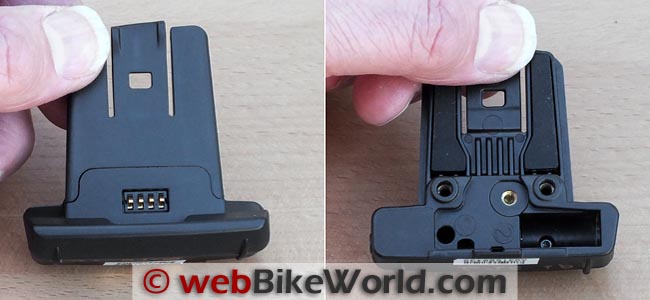
- Stylish and smaller modules.
- Modularity of components.
- Retail kit packaging.
- Best AGC in the business.
- Ultra-reliable audio stability and switching.
- Music sharing.
- Voice announcement menu.
- Online interface easy to use.
- Excellent pricing.
- Button placement.
- No voice command for volume.
- Headset speakers need improvement.
- Stereo interface cable too big
Conclusion
Both the Cardo Scala Rider Q1 and Q3 intercoms reflect Cardo design elements from earlier legacy systems, while integrating leading-edge functions and technologies, resulting in a familiar form with just about all the “bells-and-whistles” sought by motorcyclists.
In many ways, the Cardo Scala Rider G4 showed great promise, but it never seemed to realize its potential.
The long-awaited Scala Rider G9, with its impressive packaging of leading-edge technologies and capabilities was very much improved, especially in the VOX and AGC departments; these two key features being very good reasons for the popularity of the Scala Rider G9 intercom system.
So here we are with the new Cardo Scala Rider Q1 and Q3 intercoms. When used standalone or as pairs with the Q1 TeamSet and Q3 MultiSet configurations, we can state that they are absolutely the most complete and comprehensively packaged systems on the market today.
Cardo needs to take a bow for winning the “First Impressions Count” award. And everything packed in the re-useable Q1 TeamSet and Q3 MultiSet kit cases is first-rate.
All of the components provide many different fitment options for most motorcycle helmets, and once installed, motorcyclists are bound to be even more impressed with how easy these intercoms are to use — even if they only skim through the instructions.
If the Scala Rider G9 intercom system was overly complex, then the Scala Rider Q1 and Q3 systems are far less so. But they give up nothing on performance, with both the Q1 and Q3 performing well against their competition in almost every category.
At the current list price for the Q1 TeamSet and the Q3 MultiSet, Cardo has committed to some very aggressive marketing in a very competitive market; either of these intercom systems is an absolute bargain compared to the $499.95 list price of a G9 PowerSet.
I am extremely impressed with the short range rider and passenger Scala Rider Q1 TeamSet and the longer-range, rider-to-rider Scala Rider Q3 MultiSet intercom systems.
The motorcycle Bluetooth helmet intercom marketplace just got a couple of wonderful new additions.
Where to Buy Cardo Scala Rider Q1 TeamSet and Q3 MultiSet Intercom
Check Reviews & Prices on Amazon Check Reviews & Prices On RevZillaSee More: Motorcycle Intercom, Motorcycle Accessories, Motorcycle Helmets
Owner Comments and Feedback
See details on submitting comments.
From “W.” (December 2015): “Amazing review, a really point over point question answered. Only one question (maybe my fault) not answered, the battery can be replaced? Thanks and congrats.”
Editor’s Reply: The battery on this or any other Bluetooth intercom I’m aware of is not user-replaceable. The battery should last beyond the life of the intercom anyway, or you’ll probably want to upgrade to the newest technology before the battery wears out.
From “D.V.” (June 2015): “In your review of the Q3 awhile back there is no mention of Bluetooth lag?
I just set up my Q3 that I purchased earlier in the spring (before tech day) and find the audio streaming from my blackberry to be slow. Like in the older days when the batteries wore down on my Walkman.
Any ideas? It’s a brand new Q3 and a new Black Berry.”
H.B.C.’s Reply: I never noted any connection or streaming initiation issues with the Q1 or Q3 when paired with any device capable of streaming, which is what I presume you are referring to by your comments.
Lag or ‘slow’ streaming is typically related with audio streaming negotiation and initialization, sometimes attributable to the version and configuration of Bluetooth being used on the device and its firmware.
If you haven’t tried pairing the Q3 headset with one or two steaming devices, that should be done.
And also make sure that everything is up to date on both devices.
Minor bug fixes and tweaks often address audio switching along with streaming initialization, etc., although most manufacturers don’t typically highlight things like this in their notes.
Ah the Walkman…but your point about battery output was actually well made; it only takes one device to be a little under the power curve to impact things like switching and streaming.
Let us know if you get resolution and perhaps discover the issue along the way.”
Follow-up From “D.V.” (July 2015): “There is a known issue with Q3 and some phones (BlackBerry being one). Cardo has a beta software that fixes the problem; however, it can bug up the intercom function. Contact Cardo for the instructions.”
From “P.H.K.” (December 2014): “My friend and I bought the Q3 Multiset prior to a bit of touring in the Australian Outback.
This is where cattle are unfenced and wander onto the road, kangaroos and emus abound, and ‘development highways’ are one-lane wide.
So when oncoming traffic appears, including road trains (a semi pulling 5 trailers), you get off the road and try not to get blown over. In that environment, good communication seemed useful.
Installation was straightforward. I’m no tech guy, but had it my helmet set up in about 40 minutes with limited trial and error.
Then I did set up my friends helmet in about 20. My Shark and his BMW helmet both had recesses for the speakers, making it easy to locate them.
We left the next day for a 7 day trip, with about 10 hours ride time per day (c. 850k per day spread over 12 hours). The first day, believing what I read, I linked the Q3 to my phone and to my friend’s unit.
At times we talked and at times I listened to music — though only 5 or 6 songs. I always ride with Alpine earplugs: with them in, the voice clarity was great (as was the music quality with the supplied speakers).
On the down side, I’d say I got less than 8 hours before it shut down. That is, not actual use time, but 8 hours of on time, including plenty of stand by. After that first day, I stopped listening to music and only used it as an intercom.
But even with reduced usage the battery life was only about 8 hours (which would total only a couple hours of talk time).
One day I plugged it into my auxiliary plug and charged the unit in my pocket to add a few minutes of connectivity at the end of the ride, when communication tends to be most important, but that is hardly a long-term solution.
I have to wonder if my unit was set to a different level of sensitivity or if it has a bad battery because my friend’s battery never ran out during the week, while mine did every day.
On the positive side, when I found myself hitting a ‘flat spot’ where my concentration started to lapse, usually around 2:00 p.m., I found that a brief chat would revive me and sharpen the mind.
Neither my friend nor I are big talkers, but we found ourselves having good conversations in addition to pointing out safety issues or giving directions.
I’ll never again do a long tour without an intercom, and I love the ease of use with this device, but I’m worried about the longevity of the unit since the battery is not replaceable.
The microphone generally sits in place well enough, held there by a Velcro mount. But if the mike moves, the other person won’t hear you well enough to make out what you’re saying.
On my unit, the glue that attaches the mike to the Velcro pad turned to a sticky mush after 6 days (temps were in the 90s, which may be a factor). I haven’t yet found a solution to this problem.”
From “B.G.” (September 2014): “This is a summary of me and my wife’s experience of the Cardo Scala Rider Q1 intercom. We have used them since August 2013 and these are our pros and cons and wish-list:
Pros: The speakers are connected with a 3 mm jack plug which means we can use our in-ear audio ear protection easily, a very key point for us. Very good at connecting with each other and the Sena SM10. Good battery life, 8 hours constant intercom possible without re-charge. Good range and it is possible to talk to pillion through Gas/Petrol station walls etc.
Cons: Communication channel initiation time is very poor, 4+ seconds to connect with pillion after raising the Vox or pressing manual connection.
Engaged tone when both parties initiate a call, at the same time, can sometimes be at a very loud volume and with no priority given to either party, so we can be in the engaged loop for some time with a splitting headache!
The Bluetooth connection to our Garmin Zumo 660 is best forgotten, hence the purchase of Sena SM10.
Wish-list of new features: Side-tone, do you remember when you could hear yourself as well as your pillion? Audio multi-tasking, so we can discus the GPS instructions whilst both listening to them. Digital Audio Broadcasting (DAB) radio, for Europe.”
From “H.S.” (July 2014): “After reading your review, I feel I should add that I have noticed a serious shortcoming in the Q1 (firmware v1.1) when it is used with a smartphone (Samsung XCover 2) for navigation instructions (the TomTom app for Android).
The point is that there is a short delay (gradual volume increase) at the start of each instruction, due to which the first 0.5 seconds of it can’t be heard.
Quite a nuisance when this happens to the 0.5 seconds in which the number of yards or miles is mentioned: Imagine hearing “…dred yards, turn right” in stead of “After five hundred yards, turn right”.
Of course, I brought this under the attention of Cardo Systems (April 2014) and they answered that they’re aware of the problem, which in their view is a feature (the delay is designed to prevent the rider from being startled by sudden sound, they said).
Anyway, they haven’t done much since (April), no new firmware was released adding the possibility to opt-out delays for navigation use. I think this is a serious shortcoming if you want to use the Q1 to make motorcycle navigation safer.
Potential buyers may even want to postpone their purchase until a new firmware version addresses the problem.”
From “R.T.” (September 2013): “I purchased my second intercom system from a seller of the Q1 Team Set pair. After three months, the boom microphone on one of the modules stopped working.
When I contacted the company, I was told that since I had purchased it through Amazon, there was no warranty for part replacement.
You can imagine haw upset I was after hearing this from the agent and his manager at Scala rider. This is the second item from this company that has malfunctioned, the first after just over two years of use.
Again, no warranty coverage from Scala rider company.
In my opinion it is unwise for anyone to purchase any product from this company as they do not stand behind their products, which seem to malfunction with surprising regularity.
Editor’s Reply: I talked to the CEO of Cardo Wireless specifically about this issue. Just for the record, my opinion is that unauthorized resellers should be prevented from selling Cardo products and/or the warranty should be honored no matter where it was purchased.
Amazon.com should also clearly explain that the product has no warranty if sold by an unauthorized retailer.
From “B.C.” (September 2013): “I read with interest your review of the Scala Rider Q3. I purchased two units earlier this summer and agree with most everything said.
Areas of concern are:
A) The sound quality through the speakers mounted inside the helmet was not as clear as it could have been for the unit cost.
My passenger complained of the sound being tinny and echo-y. Her helmet is an open face variety. My helmet is modular.
The speakers in my helmet would not provide a volume loud enough to hear comfortably with ear plugs in. I ride regularly with ear plugs. One set of ear plugs has speakers built in.
One main reason I purchased the Q3 was because of the ability to switch between the helmet mounted speakers or a different speaker source. As you can imagine, the speaker mounted ear plugs worked great with the unit whether it was listening to my smart phone or talking with my passenger.
B) I am returning the units for this reason…the method used to attach the mic to the helmet, namely the small Velcro strip attached to the mic is, with all due respect to Cardo, far below the quality it should be.
Before long the glue ceased to adhere and the mic dangled at the end of its cord when the helmet was not being worn. Mind you, the Velcro did its job and continued to adhere to the helmet material.
Continually re-attaching the mic to the Velcro patch became such a nuisance the units have been sitting in their case for some time.
I hope the dealer will be understanding and accept the return. I am more than willing to try the Q1 sets and hope an exchange/balance refund can be worked out. Reference to this issue in your review was conspicuous by its absence.
I expect the only reason was because the review did not occur over sufficient time to allow the Velcro patch glue to loose its “stickiness”.
Thank you for your time and attention and for putting together your comprehensive review.”
From “K.S.” (August 2013): “Thanks for the great review. In studying the user manuals of the products, I noticed an error in your description, to wit:
“The exclusive Cardo “Click-to-Link” feature, first introduced on the G9, allows riders or passengers to create a spontaneous pairing between compatible Cardo Scala Rider devices owned by any one of the thousands of Scala Rider users who are potential contacts.
This is done by “clicking” the intercom modules together, which pairs them using a variant of NFC (Near Field Communications), an option that can be disabled if desired.”
You confused an aspect of the click-to-link (spontaneous intercom) feature of all the recent Cardo devices with the flash-pairing feature of the G9.
Click-to-link is initiated with button pushes or VOX, while the flash-pairing feature of the G9 uses the RFC technology to pair two devices.
Click-to-link works in addition to the available paired devices (1 to 1 in Q1, 1 to 3 others in Q3, 1 to 8 others in G9). The flash-pairing feature is not available in the Q1/3 products.
Couple other notes:
Simple VOX in Q1/Q3 (i.e., grunt or cough to initiate a feature), vs. true voice command (in G9) is a surprising let-down.
It’s understandable, though, given speech recognition requires significant processing and storage (read: hardware and perhaps software licensing costs).
Since there is Voice ‘recognition” at least, in the Q1/Q3, you might check with Cardo to see if they built in Voice Command, waiting for a priced software upgrade to activate it…
Given that G9 doesn’t support the new music-sharing feature, it seems now to be relegated to a much narrowed market segment – large coordinated group rides.
I just received the latest issue of MCN (Motorcycle Consumer News, U.S.A.), where a review of intercom devices is provided. Looks like you scooped them on the Q1/Q3.
Otherwise, your several reviews and the MCN review deliver similar conclusions. Cardo Scala products are the leaders.”
Editor’s Reply: Thanks for the catch, we had the information but it was dropped by accident in a draft of the “Common Features” section. It has been revised.
From “Z.G.” (August 2013): “In your AGV AX-8 Dual EVO review, you correctly point out the lack of a ear port for intercom speaker placement.
I’ve just installed the Cardo Scala Rider G9 intercom (review) on my AGV helmet and I am very disappointed with the volume level. I’m not sure if I have a defective speakers or unit. But with ear plugs in I can barely hear anything at speed.
I have placed the speakers as best as I can in the AX-8 helmet. It seems that you were successful withe the Scala Q3 unit installation.
It would be nice if you share how you placed the speakers in the AGV helmet, especially since you gave the helmet such positive review. Thanks! ”
H.B.C.’s Reply: In the original helmet review it was identified that the AX-8 Dual EVO did not provide specific ear pockets or speaker recesses, but there are some very fine circular markings on the helmet’s foam liner that can be seen if you look closely.
And after the Editor sent me the helmet featured in the review to facilitate my off-road riding, the AGV has hosted more more than a few Bluetooth intercom systems, with performance ratings from good to outstanding.
Speaker placement in any helmet is critical and I cannot stress that enough; with or without ear recesses, cut-outs or whatever and experience has taught me that even if the manufacturer has provided what they probably consider to be the ideal location for speakers, it probably won’t be for many users.
That is just a fact of life and its why it really does take some fine placement tuning to get the optimum from a helmet/speaker combination.
My head is a near perfect fit in the somewhat narrow AGV and with most speakers mounted using large round hook-and-loop pads stuck to the foam lining.
And the speakers mounted directly over the round pads (themselves oriented directly over the fine etchings in the liner), I haven’t had to move or adjust any of the speakers.
The Q1 and Q3 speakers are relatively small but are thicker than most, so my ears do just touch the foam covers when the helmet is in use. But to my ears, the audio is extremely good and not “tinny” sounding at all, as some users have commented on.
The Q1 and Q3 speakers are not the absolute best, but still better than what I experience with the G9 headsets and overall output volume seems better than the G9 intercoms.
For many users, there are lots of third party solutions readily adapted (see the Torx XPro speakers review) given the standard 3.5 mm stereo headset connection, but so far I have found little to complain about the standard Q1 and Q3 speakers in any helmet.
Output of my audio device is typically set at 60 to 75 percent, and with the AGV, a volume setting on the Q1 or Q3 of 5 or 6 (of the ten discrete steps) is more than enough on motorcycles with windscreens or fairings.
Whereas an un-faired motorcycle at speed typically requires a volume setting of 7 or 8, with the AGC providing almost real-time adjustments as noise levels vary.
Ear plugs are, of course, standard fare.
So without knowing any specific details about your personal and cockpit environments, my comments above are confined to my ongoing use and experiences.
The AGV is a great helmet, although noisier than many when used at speed on roads, so there will be some trade-offs depending on your riding environment.
And I just have to repeat one thing: speaker placement must be directly in line with the ear and as close as possible for comfort and safe use of the helmet.
Many helmets, depending on size and head positioning, need placement pads inserted to move the speakers closer to the ears…all the effort will pay off.
From “A.W.” (August 2013): “After much deliberation (by which I mean reading wBW’s definitive and thoughtful reviews), I purchased a Scala Rider Q3 TeamSet for myself, a lifelong technophile, and my friend, a complete technophobe.
The Q3 has been comfortable and outstanding for both of us. It’s easy to use, the intercom is phenomenal, and when it works it does exactly what I want it to.
I did find a few things a bit frustrating, and some are not the Q3’s fault, but I send them now to you because they may be helpful to someone else.
- The supplied speakers are great for intercom but tinny for music. The speakers connect with a standard headphone jack, so you can use any headphone you like.This is something sorely lacking from all other intercoms, and was a prime reason I went with the Q3. I have mounted a pair of Tork X-pro helmet speakers (review), and I couldn’t be happier.
- It can sometimes take a long time for the intercom to open after you press the talk button. Don’t get impatient and press it again, or it will disconnect the moment it connects.Even standing next to each other, it can take 15-20 seconds to open the connection.
- A2DP is great with iPhones, but it doesn’t play well with Android phones. The phone connects immediately every time and works perfectly, but it often doesn’t connect in media mode on my Samsung Galaxy S4.Every time I power the unit on, I have to manually activate media mode on my phone. Something to be aware of. Once it is paired in media mode, AVRCP works perfectly.With AGC turned to High, prepare to get blasted when you pause music; the intermediary beep causes the volume to jump to highway-speed mode for a second before it pauses.
- The Q3 does not handle ending calls gracefully on Android phones. Sometimes when a call ends, or even if you let a call go to voicemail, the Q3 will not recognize that the call has ended, and you cannot convince it otherwise.You can’t even power the unit down to restart it. Phone takes priority, so intercom, music, etc. all cease working. The only way to recover is to pull over, take out your phone, and turn Bluetooth off and on.I’ve seen this on two different Android phones now from two different manufacturers. I have never had it do this with an iPhone.”
From “T.G.” (August 2013): “Thanks for the review, I am shopping for new headsets and trying to decide what to buy.
When using a GPS and phone with the device, how much of the GPS instructions are cut off before the audio channel opens up for you to hear them? Also will it override the phone call (Pair Phone on channel 1 GPS on channel 2)?
As I am planning on going the poor-man’s route and using a Bluetooth HS adapter on my GPS instead of paying Garmin my first born child for their Zumo.
Lastly, is the audio cable waterproof? Or will you ruin the headset if you use the audio input cable while riding in the rain?”
H.B.C.’s Reply: As the Q1/Q3 intercoms have dual headset support, given your configuration of phone (basic or smartphone?) on Channel 1 and compatible GPS on Channel 2, both devices are “equal” in a sense, but the one that becomes active with audio first will become the priority.
I found the first word or two might be missed of a navigation instruction, but that was about it.
It’s not instantaneous, of course, as the device needs to activate and send the instructions and the headset needs to detect and switch to the incoming audio.
As noted in the manual and explained in the review, if the Q1/Q3 is paired with two devices primarily using the headset profile, then over-ride or priority will go to the active device or it should.
I have found on one or two occasions, depending on the devices paired, that a bit of a timeout could occur when the two devices became active.
This is probably due to the system sorting out what should be first-in, first-out for switching on devices that are seen as “equal” due to pairing. Some testing is good, as always…
If you are doing the “economy route” (used by many of us at some point in time), then just be aware that the Bluetooth adapter or BTA may or may not provide the same speed in passing the audio from the hosted device through to the headset.
You really do need to try these configurations as there is (expected or not) variances between mobile phones, smart-phones and Bluetooth adapters.
Note: Take a look at the Garmin zumo 220 as a lower-cost consideration down the road.
Regarding your question “Is the audio cable waterproof?” The audio cable (3.5 mm stereo to micro-USB) and connection is specifically identified as being part of the IP67 certification claimed by the Q1 and Q3 systems (something we need to confirm with Cardo actually).
But it does form a good seal that may prevent anything other than just some slight moisture build-up around the edges of the port. I can’t be any more conclusive right now.
And keeping the connected device out of the rain helps mitigate possible damage.
This might seem to be an obvious thing to do, but I see lots (and lots) of riders sitting or docking their devices (open or in a basic protection housing) out in the open, where the driving rain can find it…
One more note (reminder) on Q1 and Q3 Audio Priority Swapping: Knowing that many users do or will utilize any GPS capability on their smartphone (a very valid way to satisfy a requirement).
The ability to swap the two audio priorities around so that A2DP Bluetooth audio is higher priority than the intercom provides an expedient means to stream navigation audio from the smartphone’s application to the headset as Priority 2 audio.
This worked well with the iPhone and I’m now doing the same thing with the Nexus 7 as well.

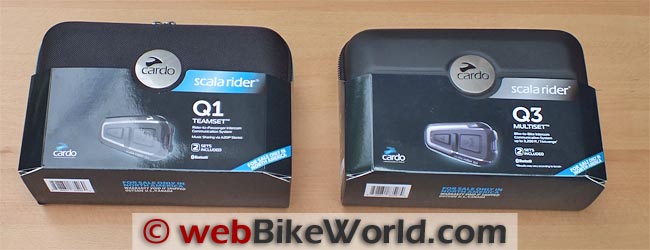


I’ve got a Scalaride Q1 fitted to my motorcycle helmet. I hardly use it because it’s impossible, to the point of being dangerous, to locate and operates the 4 buttons wih motorcycle gloves on.